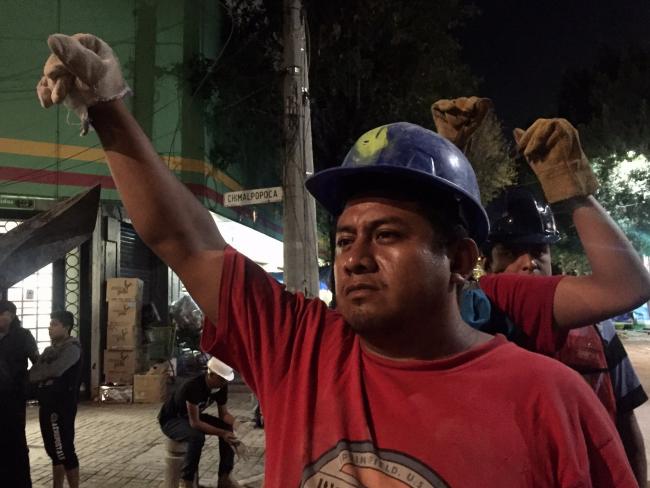There’s a new political book out by E.J. Dionne, Norm Orenstein and Thomas E. Mann, called One Nation After Trump. Dionne and Orenstein went on Fresh Air the other day to talk about their book, their take and their hopes for a better political climate. Terry Gross asked them to speak a bit about one of the themes of their book — that part of what’s notable and different about Donald Trump and the political movement behind him, as opposed to past waves of right-wing politics, is the extent to which they have embraced ideas from the European far right.
That much is certainly true, and it’s worth noting. But what’s harder to go along with is Dionne’s effort to pivot from the influence of the European far right, into a countervailing political appeal to American patriotism.
Here’s what Dionne says:
DIONNE: The idea that Bannon and Trump have imported ideas from the European far-right comes from the notion that there’s been a great historical difference between what it meant to be an American and what it meant to be a citizen in many European countries. . . . American citizenship has always been based on a commitment to ideas. It didn’t matter where you were from. It didn’t matter what the color of your skin was . . . .
–E.J. Dionne, interviewed by Terry Gross. Could The Trump Presidency Lead To An Era Of Democratic Renewal?
Fresh Air, NPR, 19 September 2017
This is just wrong. It would have been nice, and better for America and the entire world, if it had been true, but it’s flat-footedly and literally mistaken. In 1790, when Congress passed the first Naturalization Act in the U.S., the language of that act directly stated that it did matter what the color of your skin was: you had to be a free white person
to qualify for naturalized American citizenship:
Section 1. Be it enacted by the Senate and House of Representatives of the United States of America in Congress assembled, That any alien, being a free white person, who shall have resided within the limits and under the jurisdiction of the United States for the term of two years, may be admitted to become a citizen thereof, on application to any common law court of record, in any one of the states wherein he shall have resided for the term of one year at least, and making proof to the satisfaction of such court, that he is a person of good character, and taking the oath or affirmation prescribed by law, to support the constitution of the United States, which oath or affirmation such court shall administer; . . .
— An Act to establish an uniform Rule of Naturalization (March 26, 1790)
United States Statutes at Large, First Congress, Second Session, 103ff. (Source: Legally White: Naturalization Act of 1790)
Whiteness was a condition not only for naturalization, but for both the rights and obligations of citizenship more broadly, at the federal level and at the state level. Skin color prerequisites, nearly identical to the federal prerequisite, were written even more pervasively into the state constitutions and legal codes of antebellum Southern states. For example, in Alabama, the same formulas made white skin color an explicit prerequisite for the franchise and for political office. At the federal level, to take another example, in 1792 Congress said that the color of your skin (as well as your gender and citizenship) mattered to your eligibility, and obligation, to serve in the militia:
Section 1. Be it enacted by the Senate and House of Representatives of the United States of America in Congress assembled, That each and every free able-bodied white male citizen of the respective states, resident therein, who is or shall be of the age of eighteen years, and under the age of forty-five years (except as is herein after excepted) shall severally and respectively be enrolled in the militia by the captain or commanding officer of the company, within whose bounds such citizen shall reside, and that within twelve months after the passing of this act.
— An Act more effectually to provide for the National Defence by establishing an Uniform Militia throughout the United States (May 8, 1792)
United States Statutes at Large, First Congress, Second Session, 271-274. (Source: Legally White: Uniform Militia Act of 1792)
Every amendment to the Naturalization Act passed from 1790 up until 1952 repeated the free white person
formula, or a close variation on it. In 1870, in the wake of Emancipation and Reconstruction, there was a debate in the Senate over whether to remove the racial prerequisite from citizenship; but in the end the Reconstruction drive to wipe out the racial-law legacy of slavery ran up against the rising nativist sentiment against Chinese immigration in the West. And in the event, the bill that they passed never struck out the racial prerequisite; it just added aliens of African nativity and … persons of African descent
as a second racial category that could be admitted. For the next 80 years, a series of prerequisite cases
in the federal courts — beginning with In Re Ah Yup — repeatedly affirmed that skin color absolutely did matter to a person’s eligibility for American citizenship; the difficult issue that they then litigated over and over again were the sometimes porous or uncertain legal and social boundaries of just whose color counted as white
enough for government work. (For example, Chinese and Japanese immigrants did not; Mexican immigrants did. For many immigrant groups, including Arabs and South Asians, different courts made numerous, sometimes inconsistent rulings. A good, standard reference on this series of cases is Ian F. Haney-Lopez’s White By Law: The Legal Construction of Race.) Gradually Congress added more racial groups in addition to white and black, but this basic framework — of a limited number of racial categories allowed to become naturalized citizens, and everyone else ruled ineligible to citizenship
— remained the core of American naturalization law until racial bars were finally repealed by the Immigration and Nationality Act in 1952.
There is no question that for the first century and a half of its existence, the United States government was explicitly a racial state, and that race and skin color were explicit conditions on citizenship and political participation. This shouldn’t be surprising: before the Civil War, the United States was a slaveholding nation. After the Civil War, immigration exclusion and Jim Crow increasingly reinscribed systems of racial categorization into the law.
I hope it should go without saying that this is not any kind of argument in favor of race or skin color as a condition of citizenship. The fact that the United States had a long tradition of racially discriminatory citizenship laws isn’t any reason to think kindly of the traditional, white supremacist approach. It’s a reason to think worse of the United States government, and to be much more skeptical of traditional American patriotism. Whatever deeper values Dionne may think were present in the American system, at some other level, and however much he may think that the old racial prerequisite law was an aberration or an inconsistency, there is no way that you can reasonably pretend that It didn’t matter what the color of your skin was
without substituting a sort of aspirational self-identity for the much messier historical fact.



